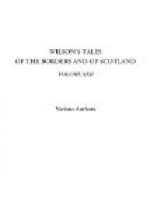“Be calm,” said I, taking him by the shoulders; “what new discovery is this? Nothing wrong with Mrs. Graeme, I hope?”
“The child,” he cried; but he could get no further.
“The child is”—
“Is what?” said I.
“Is marked on the back with the figure of the ten of diamonds.”
“Pity it was not marked where it will wear its pockets,” said I; “but it will assuredly be a very fortunate child, nevertheless, and shall bear a load of diamonds on his back like the Arabian Alcansar.”
“Are you mad?” he cried.
“Yes, with reason,” I replied. “You know, nothing appears so outrageously insane to a madman, as that same God’s gift called reason. They say, those who are bitten by the tarantula, and get dancing mad, think the wondering crowd about them raving maniacs. And there was the weeping philanthropist in the asylum of Montrose, in Scotland, who wept all day, and could not be consoled, because of all the people outside the asylum being mad.”
“But,” he gasped, “the thing is there.”
“No doubt on’t,” said I, “and you ought to be grateful. I have read somewhere of one John Zopyrus, who went mad when he heard of a son being born to him; and here you are not mad, though you have a son (I hope) born to you, with ten diamonds besides.”
“But the thing is there,” he again cried.
“Ay, there’s the rub, my dear fellow; the rub is there—let the rub be there; that is, go and rub, and the thing rubbed will not be there after the rubbing.”
“Madness, man! It is a true mother’s mark.”
“Verily, a real noevus maternus” said I, “impressed by an avenging angel on the mother’s brain, and transferred by nature’s daguerreotype to the back of the child.”
“You have said it.”
“Nay, it is you who have said it,” I continued; “and I will even suppose it is a mother’s mark, to please you for a little, though it has no more that character than this sword-prick in my left cheek. But taking it in your own way, I have a theory I could propound to you about these marks. We say that the soul is in the body. It is just as true that the body is in the soul. Every member of the entire physical person is represented in the brain, though we cannot discern the form in these white viscera. Now, see you, if a man loses his finger, his son will not be awanting in that member. But there are cases where the want of a member is hereditary. Why? Because the member was not represented in the cerebral microcosm of the first deficient person. From this small epitome in the brain, the child is an extended copy—extended from a mathematical point, where all the members and lineaments are intended. So, when the fancy of the mother is working in the brain—say, in realizing some external image—it will impress it in the cerebral person (woman) there epitomized; and if she is in a certain way, the image will go to a corresponding part of the foetal point, which is the epitome of the child. A most ingenious, and satisfactory, and simple theory, which will explain the ten-of-diamond naevus, for”——




